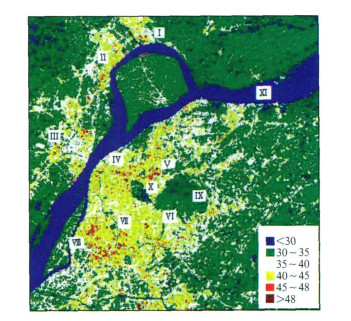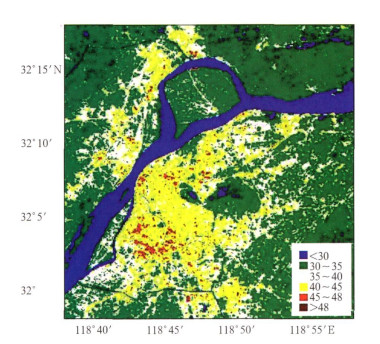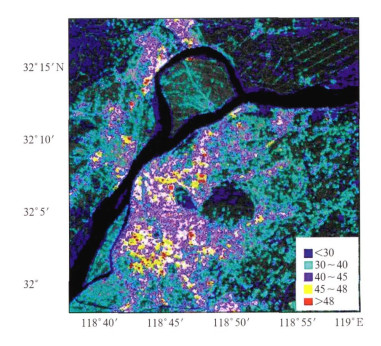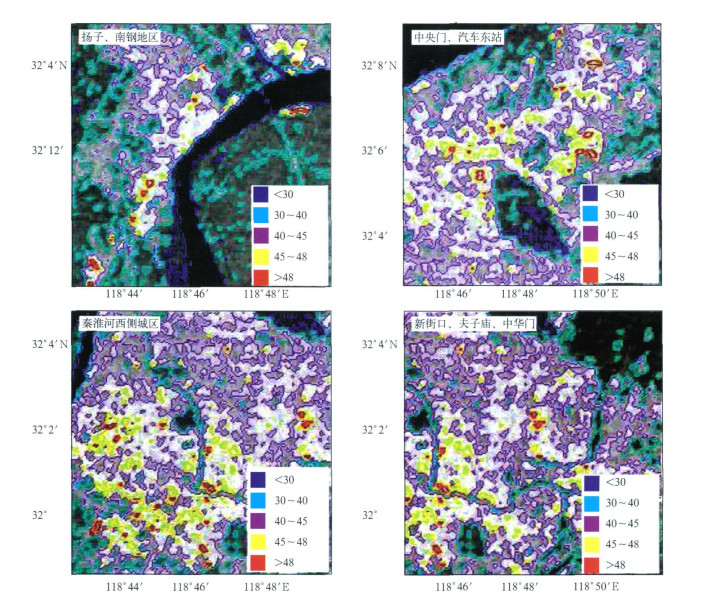利用ASTER数据分析南京城市地表温度分布
Case Study of LST Distribution in Nanjing Based on ASTER Data
-
摘要: 城市环境日益受到人们重视, 南京是长江下游人口密集的城市, 研究南京市地表温度分布对了解南京城市气候, 改善生活环境, 为城市发展规划提供有效的气象服务具有一定科学意义。该文利用2002年8月21日10:30 (北京时) ASTER热红外数据, 在ENVI软件的支持下, 通过劈窗算法反演南京城市地表温度, 进一步生成城市地表温度分布等温线图。用同时相ETM+数据进行验证, 二者十分吻合, 说明ASTER反演结果可靠。结果表明:南京市存在明显的热岛效应, 城市地表温度分布差异大; 不同下垫面的地表温度差异明显, 城区地表温度总体高于郊区, 植被覆盖密集区地表温度低于植被稀疏地, 具有较大水域面积和较密植被的城中各大公园形成多个冷岛, 长江水体温度最低; 随着城市的扩大, 新城区热岛效应更加明显。水体和密集植被能显著改善城市环境。Abstract: Urban Environment has attracted ever more attention at present. Nanjing is a densely-populated city in lower-reaches of the Yangtze River. Knowledge of land surface temperature distribution in Nanjing can help people understand urban climatic condition, especially urban thermal environment, improve the habitat and make scientific layout for urban development. In order to understand the land surface temperature distribution of the city, with the aid of ASTER thermal infrared data and split-window algorithm, its land surface temperature (LST) is retrieved under the support of ENVI software and then land surface temperature field is established. Comparing ASTER LST with ETM+ LST, the results are very accordant. Comparison between ASTER LST and actual measurement data in meteorological station results in a difference of 0.9℃, it is within the range of permissible error, indicating that LST from ASTER is reliable. Results show that there is obvious heat island effect on Nanjing city, the land surface temperature in urban is higher than in suburbs, and there are many cold islands in the urban parks with the larger water bodies and thick plants. The land surface temperature of different space has great discrepancies: The maximal temperature is 56 ℃, the minimum temperature is 23 ℃, with a difference of 33 ℃. There is notable difference in surface temperature among different land uses: The surface temperature is the highest in the regions of asphalt concrete surface in the sun; it is higher in sparse vegetation regions than in dense vegetation cover regions; it is higher in sparse human regions than in dense human regions; the minimum temperature is found over the Yangtze River. On the whole, the surface temperature is higher in the south of Yangtze River, Dachang and Qiaobei than other regions, where it is generally more than 40 ℃. LST exceed 45 ℃ in some districts, including Dachang, Nangang, Qiaobei, Zhongyangmen, east bus station, Xinjiekou, Fuzimiao, Zhonghuamen, the west of Qinhuai River and Yuhuatai, showing characteristics of fleck. The regions where LST exceed 48 ℃ concentrate in Zhongyangmen, Xinjiekou, east bus station, and west of Qinhuai River. The temperatureis lower than 35 ℃ in Zijin Mountain, Xuanwu Lake, Qinhuai River and some urban parks with the larger water bodies and thick plants and LST of Yangtze River is under 30 ℃. With the expansion of city, the heat island effect is even more remarkable in the newly urbanized regions, but the water and the highly dense vegetation in urban help mitigate the thermal effect.
-
图 2 2002年8月21日10:30南京地区ASTER数据的地表温度反演结果 (单位:℃)
(所示区域分别为:Ⅰ-扬子; Ⅱ-南钢; Ⅲ-桥北; Ⅳ-中央门; Ⅴ-汽车东站; Ⅵ-新街口; Ⅶ-中华门; Ⅷ-秦淮河西侧城区; Ⅸ-紫金山; Ⅹ-玄武湖; Ⅺ-长江)
Fig. 2 Result of LST rerieved based on ASTER data at 10:30 21 Auguest 2002 in Nanjing area(unit:℃)
(the region shown in Fig.2:Ⅰ-Yangzi; Ⅱ-Nangang; Ⅲ-Qiaobei; Ⅳ-Zhongyangmen; Ⅴ-east bus station; Ⅵ-Xinjiekou; Ⅶ-Zhonghuaman; Ⅷ-west city of Qinhuai River; Ⅸ-Zijin Mountain; Ⅹ-Xuanwu Lake; Ⅺ-Yangtze River)
-
[1] 陈云浩, 李京, 李晓兵.城市空间热环境遥感分析---格局、过程、模拟与影响.北京:科学出版社, 2003. [2] 郑祚芳, 范水勇, 王迎春.城市热岛效应对北京夏季高温的影响.应用气象学报, 2006, 17(增刊): 48-53. http://www.cnki.com.cn/Article/CJFDTOTAL-YYQX2006S1006.htm [3] 宋艳玲, 张尚印.北京市近40年城市热岛效应研究.中国生态农业学报, 2003, 11(4): 126-129. http://www.cnki.com.cn/Article/CJFDTOTAL-ZGTN200304038.htm [4] 何全军, 吴志军, 张月维.利用MODIS热红外数据进行广州市夏季热场分析.遥感技术与应用, 2005, 20(5): 501-505. http://www.cnki.com.cn/Article/CJFDTOTAL-YGJS200505008.htm [5] 张光智, 徐祥德, 王继志, 等.北京及其周边地区城市尺度热岛特征及其演变.应用气象学报, 2002, 13(特刊): 43-49. http://www.cnki.com.cn/Article/CJFDTOTAL-YGJS200505008.htm [6] 李延明, 张济和, 古润泽.北京城市绿化与热岛效应的关系研究.中国园林, 2004(1): 72-75. http://www.cnki.com.cn/Article/CJFDTOTAL-ZGYL200401020.htm [7] 宫阿都, 李京, 王晓娣, 等.北京城市热岛环境时空变化规律研究.地理与地理信息科学, 2005, 21(6): 15-18. http://www.cnki.com.cn/Article/CJFDTOTAL-DLGT200506004.htm [8] 李俊杰, 何隆华, 陈杰.南京城市热场的卫星遥感分析.长江流域资源与环境, 2005, 14(6): 760-763. http://www.cnki.com.cn/Article/CJFDTOTAL-CJLY200506017.htm [9] 唐伶俐, 陈刚, 戴昌达.南京市热岛效应的卫星遥感.国土资源遥感, 1993, (2): 6-9. http://www.cnki.com.cn/Article/CJFDTOTAL-GTYG199302004.htm [10] 程博, 刘少峰. TERRA卫星ASTER数据的特点与应用.华东地质学院学报, 2003, 1(26): 15-17. http://www.cnki.com.cn/Article/CJFDTOTAL-HDDZ200301003.htm [11] 俞宏, 石汉青.利用分裂窗算法反演陆地表面温度的研究进展.气象科学, 2002, 22(4): 494-450. http://www.cnki.com.cn/Article/CJFDTOTAL-QXKX200204015.htm [12] Price J C.Land surface temperature measurements from the split window channels of the NOAA7/ AVHRR.J Geophys Res, 1984, 79:5039-5044. doi: 10.1029/JD089iD05p07231/full [13] Becker F.The impact of spectal emissivity on the measurement of land surface temperature from a satellite.Int J Remotesens, 1987, 8(10):1509-1522 doi: 10.1080/01431168708954793 [14] Cooper D, Asrar G.Evaluating aimospheric correction models for retrieving surface temperatures from the AVHRR over a tall grass prairie.Remote Sens Environ, 1989, 27:93-102. doi: 10.1016/0034-4257(89)90040-0 [15] Backer F, Liang Lizhao.Towards a local splite window method over land surface.Int J Remote Sens, 1990, 11:369-393. doi: 10.1080/01431169008955028 [16] 杨俊泉, 黄承标, 莫伟华, 等.陆面温度劈窗算法的试算对比与应用.广西大学学报 (自然科学版), 2004, 29(增刊):80-85. http://www.cnki.com.cn/Article/CJFDTOTAL-GXKZ2004S1026.htm [17] 毛克彪, 覃志豪, 施建成, 等.针对MODIS影像的劈窗算法研究.武汉大学学报 (信息科学版), 2005, 30(8):703-707. http://www.cnki.com.cn/Article/CJFDTOTAL-WHCH200508010.htm [18] 毛克彪, 唐华俊, 陈仲新, 等.一个从ASTER数据中反演地表温度的劈窗算法.遥感信息, 2006, (5): 7-11. http://www.cnki.com.cn/Article/CJFDTOTAL-YGXX200605004.htm [19] Kaufman Y J, Gao B C.Remote sensing of water vapor in the near IR from EOS/ MODIS.IEEE Transactions on Geo science and Remote Sensing, 1992, 30:871-884. doi: 10.1109/36.175321 [20] Salisbury J W, D' Aria D M.Emissivity of terrestrial materials in the 8-14 mm atmospheric window.Remote Sens Environ, 1992, 42:83-106. doi: 10.1016/0034-4257(92)90092-X [21] Sobrino J A, Raissouni N, Li Z L.A comparative study of land surface emissivity retrieval from NOAA data.Remote Sens Environ, 2001, 75:256-266. doi: 10.1016/S0034-4257(00)00171-1 [22] Labed J, Stoll M P.Spatial variability of land surface emissivity in the thermal infrared band:Spectral signature and effective surface temperature.Remote Sens Environ, 1991, 38: 1-17. doi: 10.1016/0034-4257(91)90068-H [23] 高懋芳, 覃志豪.中国MODIS地表温度产品验证.国土资源遥感, 2006, (3): 15-18. http://www.cnki.com.cn/Article/CJFDTOTAL-GTYG200603004.htm [24] 叶柯, 覃志豪.基于MODIS数据的南京市夏季城市热岛分析.遥感技术与应用, 2006, 21(5):426-431. http://www.cnki.com.cn/Article/CJFDTOTAL-YGJS200605004.htm [25] 佟华, 刘辉志, 李延明, 等.北京夏季城市热岛现状及楔形绿地规划对缓解城市热岛的作用.应用气象学报, 2005, 16(3): 357-366. http://qikan.camscma.cn/jams/ch/reader/view_abstract.aspx?file_no=20050344&flag=1 -


 设为首页
设为首页 加入收藏
加入收藏



 下载:
下载:




